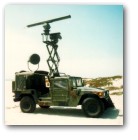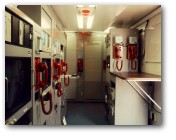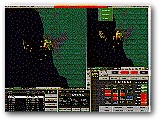




The current Mobile Inshore Undersea Warfare (MIUW) system consists of a 8 ft by 20 ft transportable AN/TSQ-108A Radar Sonar Surveillance Center (RSSC) van which is used as a command center. The sensors, located in and on the RSSC include a SPS-64 radar and a AN/SQR-17A for sonar buoy processing. Lookouts use binoculars or electronic imaging equipment for visual classification/identification of targets. MIUW units used this type of equipment configuration while deployed during Operation Desert Shield/Storm. Based on their experiences as well as advances in commercially available technology over the past several years the decision was made by the Navy to provide an upgrade to the MIUW system.
The MIUW System Upgrade Program will significantly improve the capabilities of the MIUW community. The new baseline system consists of an upgraded AN/TSQ-108A Radar Sonar Surveillence Center (RSSC) van with a Portable Sensor Platform (PSP), a Mobile Sensor Platform (MSP), and a lightweight, small boat deployable, underwater sensor string. In addition, a number of portable Readiness Trainer Systems are being built which can be easily moved from van to van.The MSP is a sensor platform built onto a HMMWV to permit rapid deployment and maximum site flexibility. The remote sensors consist of a Thermal Imaging Sensor (TIS) and a Visual Imaging Sensor (VIS) (co-located on a computer controlled pan and tilt mechanism) and a Furuno X-Band surface search radar with a CEA radar track processor system. Telemetry of radar data and imagery back to the van over a 10 Km line-of-sight distance is provided by a microwave transceiver with capability for future upgrades to fiber-optic cable. A stand-alone controller provides on-site operation if needed.
 |
 |
| MSP | Rear view |
The RSSC van has been upgraded to a V3 configuration. The new RSSC contains sensor processing hardware (including an upgraded AN/SQR-17A(V)3 acoustic processor, an ESM system and a Furuno/CEA radar system) as well as upgrades to the communications suite including Joint Maritime Command Information System (JMCIS) network access, Fleet Broadcast, and PC Based message management. A trailer-based PSP permits remoting of most antennas and emitters up to 150 feet away from the van if needed.
 |
 |
| RSSC van | Inside view |
 |
| GDFS screen |
The display is user friendly, with scaleable maps, pop-up windows for sensor control and calibration, target icons using NTDS symbology and selectable zones of target acquisition and non-interest. If desired, the actual radar video from one or all of the radars can be underlaid onto the display. Target data can be stored, replayed and selectively routed into case files or into JMCIS.
A passive underwater array sensor string, configured to be deployable from a small boat, will be included in the upgrade. Development of omni passive strings and active sonars for close-in swimmer detection are under consideration for future inclusion. The array string in conjunction with the continued use of sonar buoys and an upgraded acoustic processor tied to the GDFS will give the MIUW units a significantly improved shallow water surveillance capability.
The MIUW System Upgrade program, sponsored by OPNAV N852G and managed by the Office of Special Technology, will provide an integrated upgrade of MIUW equipment and capabilities using primarily off-the-shelf equipment. Six upgraded RSSC van systems have been delivered to date, with 11 more in production. The production schedule is planned with the goal of re-outfitting most MIUW units nationwide by the end of the decade, at the rate of five vans per year.
Contacts
| MIUW-SU Program Office Space and Naval Warfare Systems Command (PMW-182) San Diego, CA 92110-3127 Phone: (619) 524-7278, FAX: (619) 524-3030 SPAWARSYSCEN D372 |
